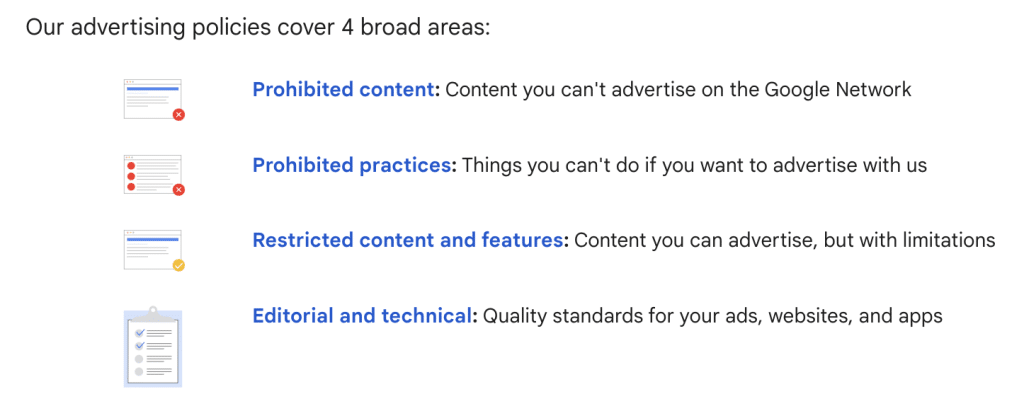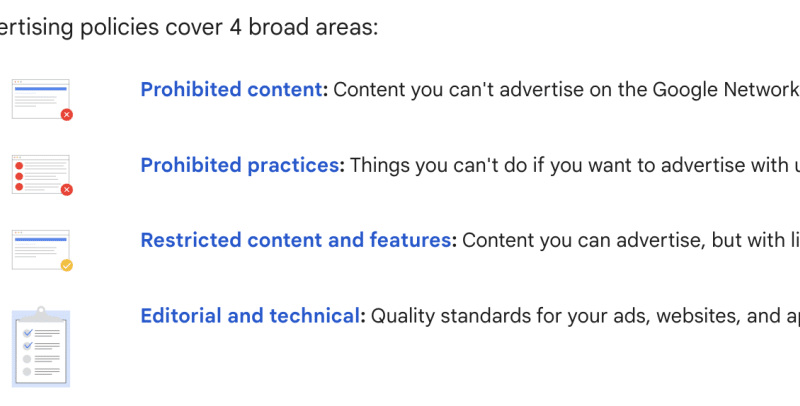Google Ad Policies Explained for Business Owners
Google’s advertising platform is the largest and most influential in the world. To maintain the trust of users and ensure a high standard across all its advertising services, Google has implemented detailed ad policies. These guidelines are crucial for advertisers aiming to reach audiences ethically and effectively. This article will dive into these policies, focusing on prohibited content, transparency, and ongoing adherence to changing regulations.
- Google ad policies are designed to uphold ethical, legal, and user-friendly standards.
- Advertisers must adhere to content and format guidelines, with specific restrictions on certain products or services.
- Regular updates to these policies ensure alignment with new laws and user expectations.
Prohibited and Restricted Content
Google’s ad policies clearly outline content that is either prohibited or restricted. Prohibited content includes items that promote hate speech, illegal activities, or misleading practices. It’s essential for advertisers to avoid these topics since they can result in ad disapproval or account suspension.
Restricted content and features refers to products or services that can be advertised under certain conditions. Examples include alcohol and gambling, where ads must meet specific criteria and often include age restrictions. These guidelines ensure such content does not reach inappropriate audiences, maintaining a healthy advertising environment. The last is editorial and technical, which prevents advertisers from using text manipulations like F₹€€!! rather than saying FREE or using outdated web technology which creates vulnerabilities for users.

Ad Format Requirements
In addition to content guidelines, Google has set standards for ad formats to enhance user experience. Ads must be clear, professional, and fit neatly within specific formats, whether they’re search ads, display ads, or video ads. Misleading formats are not allowed. For example, if a client of a google advertising agency was mimicking system notifications, that would be prohibited because it can deceive users. Adhering to these format requirements not only aligns with Google’s policies but also increases the likelihood of reaching your target audience effectively.
Emphasizing Transparency and User Privacy
Transparency in advertising is a crucial pillar of Google’s ad policies. Advertisers are required to be honest in their advertisements, clearly stating what the user can expect from clicking an ad. This includes being straightforward about product prices, performance, and any additional terms.
User privacy is also a top priority. Google mandates that advertisers respect user data, requiring explicit permission for data collection and the correct usage of that data, in line with privacy laws like GDPR. Building trust through transparent and privacy-conscious ads can improve user engagement and bolster brand credibility.
Regular Policy Updates
Google regularly updates its ad policies to keep pace with evolving legal and societal standards. These updates may be influenced by new regulations or shifts in user expectations. Advertisers need to stay informed about these changes to ensure compliance and prevent any potential disruptions to their advertising campaigns. Subscribing to Google’s policy update notifications can be an excellent way to keep track of these changes.
Google’s ad policies play a fundamental role in establishing a safe and trustworthy environment for advertisers and users alike. By understanding and adhering to these policies, advertisers can avoid the pitfalls of non-compliance, such as ad disapproval or account suspension. It can also help you understand what trends to expect from Google ads in the future. What aspect of Google’s ad policies do you find most crucial for maintaining user trust?
